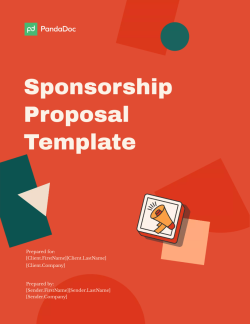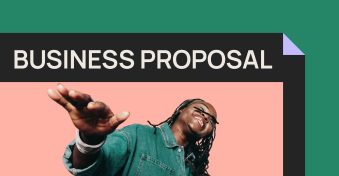Every year, corporate sponsors spend a combined $1 billion, and 75% of them are constantly searching for new partnerships.
To secure one of these sponsors for your event, you need an engaging and persuasive sponsorship proposal. Here are six essential steps that will help you convince decision-makers to provide the funding you need.
Tip 1: Approach the potential sponsor
How do you ask a company to sponsor you?
A sponsorship proposal is essentially a sales pitch, and all sales messages are most effective when they target the prospect’s needs. Before writing a word of your sponsorship proposal letter, contact the potential sponsoring organization and discuss their needs.
Don’t make this conversation about your event or sponsorship opportunities. In fact, try not to mention those topics at all, outside of your conversation opener. Instead, ask about how the company has approached corporate sponsorship in the past.
Hints:
- Focus on your potential sponsor. There’ll be plenty of time to sell your event later. For now, frame all of your questions and answers in terms of their needs.
- Keep your questions open-ended. You’ll receive more information if you let the prospect give you their ideas, instead of the other way around.
Examples:
- What kinds of assets (exhibit booth space, brand logo on swag, live mentions at event) have the most value to you?
- What do you like to see in a sponsorship package?
- How would you describe your target audience?
Tip 2: Write the event description
The first section of your sponsorship proposal letter should introduce your event in detail, informing the prospect why it’s worth their time and money.
Elaborate the basics about the event, including the number of attendees you’ve welcomed in the past and what you anticipate as some of this year’s highlights. Next, add any information that directly connects your event to the sponsor’s interests, such as:
- Speakers that are big draws in your potential sponsor’s industry
- Relevant product launches or research presentations
- Event selling points that audiences can’t get anywhere else
Here, your main goal is to present the event as something that your sponsor’s audiences won’t want to miss. Don’t be afraid to tell the sponsor outright that you’re offering them the chance to get in front of their target audiences.
Hints:
- Describe the event purpose. Shedding light on the impact of the event can earn corporate sponsorships, especially if you run a nonprofit. Show potential sponsors what their support will help you to achieve, and who it will impact.
- Target the proposal letter to the sponsor. Review how they described their target audience and include relevant facts about your event.
Example:
A software conference could successfully appeal to sponsors by highlighting the fact that the previous year’s event sold-out. The proposal might also shed light on the event’s popularity and established reputation in other ways, including:
- Attendance: How much did registration increase year-over-year?
- Geographic reach: How many countries did attendees come from?
- Social media shares: Were there tens of thousands of shares? Hundreds of thousands?
- Event content: What kind of talks have renowned experts offered?
You can start your proposal with an event breakdown like this, then include another section to dive deeper and share a bit more about the audience. In that section, you’ll provide sponsors with a clear understanding of whose eyes will be on their brand.
Tip 3: Create an audience profile
The more you can connect your event audience with the potential sponsor’s target market, the better.
Begin by reminding yourself of the target market and sales goals. Draw from any prior conversations you’ve had and complete some background research if necessary. Find out who they want to reach and think about which of those demographics also applies to your event audience.
Once you have that information, inform the sponsor about your audience. Include statistics that show what sectors your audience members work in and what positions they hold. You can also include data explaining why guests attend your event and what their professional pain points are.
For this section, opt for graphics over bullet points or paragraphs of text. Statistics can be dry and difficult to understand. Infographics are more engaging and help a reader to see why a statistic matters.
Plus, according to PandaDoc research, proposals with visuals are 32% more successful than those without.
Hints:
- Highlight the most important data. Sponsors don’t need to know everything; just the facts that connect your event to their target audience. If there’s a data point that doesn’t matter to a prospect, leave it out.
- Find out how many attendees already work with the prospective sponsor. One way to do this is to make a list of potential sponsors and then send out a survey to past attendees, asking them which companies they’ve bought from in the past.
Example:
Imagine your event welcomes developers and users of data analysis tools. You might use percentages to show potential sponsors who they can reach, and what those audience members’ interests are.
In other words, you can show which professional roles are best represented at the event by percentage of attendee population. For example:
- Developer/Engineer: 33%
- Data Scientist: 24%
- Senior Leadership: 23%
- Academic: 11%
- Analyst: 9%
This helps the reader comprehend how numbers that might seem small — say 30%, or even 25% — are actually significant portions of the event’s attendee base.
Another great choice is to list popular conference discussion topics; for example, machine learning, artificial intelligence, and predictive modeling. This helps potential sponsors to understand why the event’s audience is a good match for them.
Furthermore, including a “Benefits of Sponsorship” section ensures that potential sponsors know not only who they can reach, but also why this matters. This is a great set of points to include if a company isn’t quite sold on the concept of sponsorship yet, or if it isn’t sure just how your event relates to its goals.
By including this section, you effectively inform potential sponsors of not only who they can reach, but also why that matters.
Tip 4: Introduce sponsorship levels
Next to “What’s in it for me?,” the biggest question that a decision-maker will have about sponsorship is how much it costs. Packages make it easy to communicate value to a potential sponsor. They also shift the focus away from the price to what the company will receive in exchange for its sponsorship dollars.
If you haven’t already, identify sponsorship levels and what each one includes.
Elaborate benefits such as:
- Booth space
- Logo placement (on flyers, banners, backdrops, etc.)
- Digital mentions (backlinks, email mentions, web page features, etc.)
- Number of tickets included
You may also decide to offer à la carte sponsorship options. These might be the same benefits as a package buyer would get. You might also offer unique options that the sponsor can’t get anywhere else, for example:
- Naming rights to a particular event area or program element
- Branded video welcome messages
- MC or speaker opportunities
- Social media backlinks
If any specific asset ideas came up in prior conversations with a prospective sponsor, add them to the proposal as well.
You can also open yourself up to sponsor suggestions. Don’t commit to custom sponsorships in your letter, but you can use language like:
Do these options give you any ideas we haven’t covered? Let us know. We’re always happy to discuss new possibilities.
Hints:
- Highlight top-level sponsorships. One way to do this is by putting the benefits of the highest-level sponsorships at the top of your sponsorship levels grid. Those top-tier benefits will be the first that potential sponsors see and, hopefully, the last they’ll want to give up.
Example:
If you have sponsorship levels and à la carte options, you can drive interest by listing each benefit and clearly indicating which sponsors enjoy that benefit. For example:
- Daily session: Main sponsors only
- Company booth: Main and social sponsors
- Marketing media inclusion: All sponsors
- Description in program: Up to a page, depending on sponsorship levels
This encourages larger sponsors to spend more, showing them what they’d miss out on with a lower-ticket sponsorship. Meanwhile, it pulls in the smaller sponsors, highlighting the availability of more affordable choices.
Tip 5: Add terms, conditions, and a call to action
These sections may not be the most exciting part of the corporate sponsorship proposal, but that’s okay. If you’ve followed the steps above, you’ve already done the work of motivating them.
This section is where the sponsor officially says “yes.” An exciting way to begin is with an order form, where the sponsor indicates their desired sponsorship level or option.
Next, you need to cover the logistical details so that they know what they have to do to get on board. Identify both your responsibilities and the sponsor’s, including the amount of the sponsor’s contribution.
Finally, close the document with a signature field. This permits you to use the proposal as a contract and minimize the back-and-forth before you get a commitment.
Hints:
- Use a customizable template. Templates like PandaDoc’s include terms and conditions, so all you have to do is review them and add anything specific to your event.
- Use bullet points or short paragraphs. Like statistics, rules and regulations can be difficult to read. Breaking them up makes them more scannable.
Example:
Providing a thorough “Service Details” list allows organizers to touch on FAQs and contract issues in the same place. The section covers points such as:
- Pricing and packaging are subject to availability.
- Sponsors must provide their own physical marketing materials.
- Booths include one table and a chair, but sponsors may bring their own extras.
- Sponsor ticket vouchers are non-redeemable and available up until a specified deadline.
A comprehensive list shows sponsors that you’re organized and professional, while helping to fill in knowledge gaps that they may not have known they had.
Tip 6: Choose the right event sponsorship proposal template
It’s possible to create every proposal document that you send from scratch, but it’s much faster and far easier to use a letter template.
PandaDoc’s sponsorship proposal template is easy to use and fully customizable. You can make each one unique and gear it to the sponsor you want to land, without having to create a new one every time.
Plus, with PandaDoc you can personalize text as well as graphics. You can add videos and customize the cover page so that it fits the theme of your event. You can even add each potential sponsor’s logo and colors to the cover page for extra personalization.
With PandaDoc’s template and these tips, you’re ready to start funding your next event.
Originally published July 21, 2015, updated March 10, 2021
Disclaimer
Parties other than PandaDoc may provide products, services, recommendations, or views on PandaDoc’s site (“Third Party Materials”). PandaDoc is not responsible for examining or evaluating such Third Party Materials, and does not provide any warranties relating to the Third Party Materials. Links to such Third Party Materials are for your convenience and does not constitute an endorsement of such Third Party Materials.

